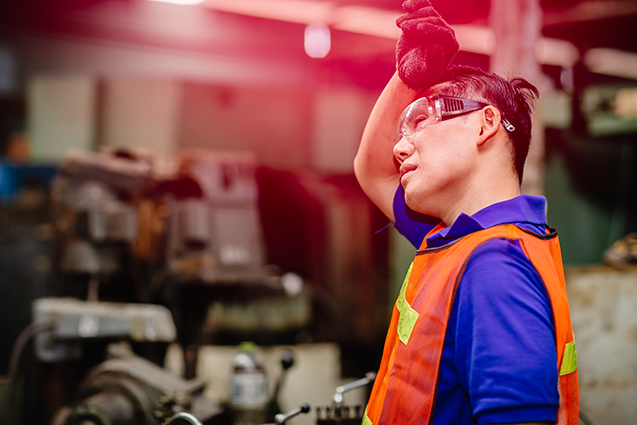Share this
If Your Mechanical Seals Need Repair Too Often—Do This
by Paul Lesnau on 6/18/20 8:45 AM

Like most refinery rotating equipment engineers, you have hundreds of different pumps to take care of. While some of the refinery's rotating equipment is in better shape than others, a mechanical seal failure somewhere along the line is inevitable—especially in some of the older California Bay area petrochem plants. You can usually take care of these problems quickly. But, when a mechanical seal is failing repeatedly, it is time to look at the other subsystems.
If you have a seal with known alignment problems, problems with insufficient cooling, or recurrent seal plugging, a root cause analysis should include taking a closer look at the seal support system. An obsolete or insufficient seal support system can result in a variety of mechanical seal repair problems: leaks, seal face damage, or excessive process fluid leaking into the buffer fluid.
You don’t need those problems on top of everything you are already taking care of. So, it’s best to develop a preventative maintenance plan that includes identifying “bad actor” mechanical seals and determining whether they need a seal support system upgrade or replacement.
Frequent Mechanical Seal Repairs? Here’s What to Check
You already have maintenance records in hand and know which pumps to prioritize because of frequent mechanical seal repairs. Then, it’s time to start troubleshooting the seal support systems that are not functioning optimally. The process of checking the seal support system for brewing trouble may be familiar—it’s very similar to specifying a new system. But, even if you’ve never done that before, you won’t feel overwhelmed here.
Let’s get started, one step at a time.
Step 1: Examine the process conditions and fluid.
Has anything changed, even if “just a little?” An insufficient seal system may not keep new contaminants out of the seal or the process fluid may no longer have good enough lubricity. You may need a new barrier/ buffer fluid. Or, if you can’t use the process fluid anymore, especially on a dual seal, it might be time for a new seal support system.
Step 2: Re-check for fugitive emissions.
Many problems first show up as small seal system leaks. Small leaks only get bigger and will eventually become reportable. You’ll need to first fix the mechanical seal then go back and look at why the damage occurred in the first place. You might find that an upgrade or replacement needs to be added to the budget.
Step 3: Take a good look at the seal support system instrumentation.
Can you measure flow, pressure, or fluid temperatures? Should any of this data be recorded automatically? Too often excessive heat build-up could be seen with seal system instrumentation but isn’t noticed until there is a catastrophic failure.
It’s not uncommon that the instrumentation broke, operators stopped looking at it for early warning signs, and nobody got around to fixing it. If that’s the case, the time is now for resolving the problem by getting new instrumentation.
Step 4: If you can measure seal fluid conditions, are they appropriate for the service?
If not, you may not have proper lubrication or heat removal. The data can be right there in front of you showing a pump seal running too hot, but if no one checks…
Yes, that means you need to upgrade the seal system to get proper heat removal restored.
Step 5: If there is a seal fluid cooler, can you verify inlet and outlet temperatures?
Small equipment like the cooling coils or smaller heat exchangers are often neglected. Does the cooler need to be cleaned or replaced? Aged and failing coolers are a simple fix that can avoid a much more expensive seal replacement if they are left unattended until failure.
Step 6: Are you using the best barrier or buffer fluid?
Too often water is used because it was cheap and readily available but it is only marginally acceptable. Seal replacements are often more frequent than they have to be, resulting in higher lifecycle costs. The variety and performance of engineered barrier fluids have improved greatly over the last few decades.
Step 7: Is the system accessible and easy to operate?
Human factors are easy to ignore. “It's always been like that” is a common retort and, unfortunately, looking at the equipment is often skipped on rounds too! No one likes to talk about the unnecessary mechanical seal failures that have happened as a result of this.
Getting a consultation from a vendor who can Design/Build a new seal support system can help solve the problems with ergonomics in hard-to-fit spaces. It’s your best prevention plan.
This was a long list of things to look at, but it doesn’t have to be hard—especially if you have the support to do the job right the first time. Mechanical seal replacements are expensive and so is downtime. An ounce of prevention with good seal system maintenance and, especially, an expert consultation with a seal support vendor is well worth the effort.
Achieve Better Mechanical Seal Reliability With Support
A solid seal support system vendor can help you both with reliability projects for mechanical seals and obtaining the right upgrade or system when needed. Often, your seal support systems don’t need to be completely replaced; a few upgrades can improve performance enough to extend your equipment’s useful lifespan. But, if it does, a top vendor will provide several options to suit both the service and the budget.
Swagelok’s highly-skilled team of local engineers are available to help you with all your seal system needs. We can be onsite quickly to help with troubleshooting and evaluating seal systems on any pump, not just your biggest problem pumps. If needed, we can design and fabricate anything from small fixes to full replacements in our local Concord, CA shop. Our seal support system Design/Build option means we can also help address unique seal system problems such as ergonomics or human factors of an old installation.
At Swagelok Northern California, we understand the needs of Bay Area refineries and can help when your mechanical seals need repair—no matter how big or small the issue. Contact our team today by calling 510-933-6200.
 About Paul Lesnau | Sales Manager, Business Development Manager, and Field Engineer
About Paul Lesnau | Sales Manager, Business Development Manager, and Field Engineer
Paul holds a B.S. in Mechanical Engineering from North Dakota State University. Before joining Swagelok Northern California, he was the West Coast Regional Sales Manager for an organization based in Illinois involved in pneumatic and hydraulic applications where he supervised product distribution throughout the western United States, Canada, and Mexico. While in this role, he was able to help provide technical and application-specific expertise to customers and distribution to drive specifications.
Share this
- Archive (465)
- Assembly Services (207)
- About (100)
- Seal Support Systems (96)
- Best Practices (88)
- Training Services (74)
- Fittings (51)
- Semiconductor Applications (49)
- Hoses and Flexible Tubing (47)
- Regulators (44)
- Tubing (42)
- Grab Sampling Systems (32)
- Sampling Systems (32)
- Gas Systems (30)
- Services (30)
- Downloads (29)
- Valves (24)
- Application Support (18)
- Orbital Welding (17)
- Case Studies (13)
- Steam Systems (13)
- Frequently Asked Questions (12)
- Tools (12)
- Measurement Devices (7)
- Subsystems (6)
- Thermal Management (6)
- September 2023 (1)
- August 2023 (2)
- June 2023 (1)
- March 2023 (3)
- February 2023 (3)
- January 2023 (4)
- December 2022 (4)
- November 2022 (4)
- October 2022 (4)
- September 2022 (1)
- August 2022 (3)
- July 2022 (2)
- June 2022 (4)
- May 2022 (1)
- April 2022 (2)
- March 2022 (1)
- February 2022 (2)
- January 2022 (3)
- December 2021 (1)
- November 2021 (6)
- October 2021 (6)
- September 2021 (8)
- August 2021 (4)
- July 2021 (3)
- June 2021 (6)
- May 2021 (6)
- April 2021 (7)
- March 2021 (5)
- February 2021 (4)
- January 2021 (6)
- December 2020 (5)
- November 2020 (6)
- October 2020 (6)
- September 2020 (8)
- August 2020 (7)
- July 2020 (8)
- June 2020 (8)
- May 2020 (6)
- April 2020 (9)
- March 2020 (7)
- February 2020 (10)
- January 2020 (21)
- December 2019 (23)
- November 2019 (21)
- October 2019 (22)
- September 2019 (21)
- August 2019 (22)
- July 2019 (23)
- June 2019 (20)
- May 2019 (23)
- April 2019 (22)
- March 2019 (21)
- February 2019 (20)
- January 2019 (21)
- December 2018 (14)
- November 2018 (19)
- October 2018 (23)
- September 2018 (17)
- August 2018 (29)
- July 2018 (11)
- June 2018 (6)
- May 2018 (5)
- April 2018 (4)
- March 2018 (5)
- February 2018 (3)
- January 2018 (3)
- December 2017 (2)
- November 2017 (4)
- October 2017 (3)
- September 2017 (2)
- August 2017 (6)
- July 2017 (4)
- June 2017 (4)
- May 2017 (4)
- April 2017 (3)
- March 2017 (4)
- February 2017 (3)
- January 2017 (3)
- December 2016 (3)
- November 2016 (3)
- October 2016 (3)
- September 2016 (5)
- August 2016 (5)
- July 2016 (4)
- June 2016 (5)
- May 2016 (3)
- April 2016 (4)
- March 2016 (5)
- February 2016 (11)
- January 2016 (1)
- December 2015 (3)
- November 2015 (4)
- October 2015 (3)
- September 2015 (4)
- August 2015 (4)
- July 2015 (8)
- June 2015 (5)
- May 2015 (3)
- April 2015 (4)
- March 2015 (4)
- February 2015 (3)
- January 2015 (4)
- December 2014 (2)
- November 2014 (3)
- October 2014 (4)
- September 2014 (4)
- August 2014 (4)
- July 2014 (5)
- June 2014 (4)
- May 2014 (4)
- April 2014 (5)
- March 2014 (4)
- February 2014 (3)
- January 2014 (4)
- December 2013 (5)
- November 2013 (3)
- October 2013 (4)
- September 2013 (3)
- August 2013 (5)
- July 2013 (5)
- June 2013 (5)
- May 2013 (3)
- April 2013 (6)
- March 2013 (4)
- February 2013 (4)
- January 2013 (8)
- December 2012 (4)
- November 2012 (6)
- October 2012 (6)
- September 2012 (4)
- August 2012 (4)
- July 2012 (4)
- June 2012 (4)

.webp?width=210&height=70&name=StickyLogo%20(5).webp)